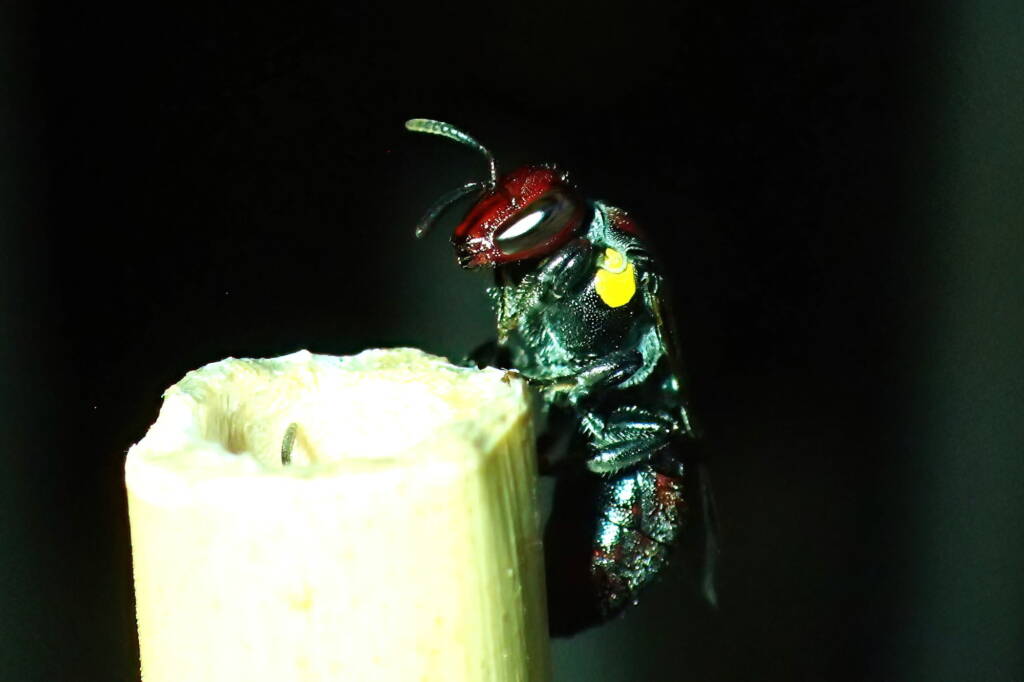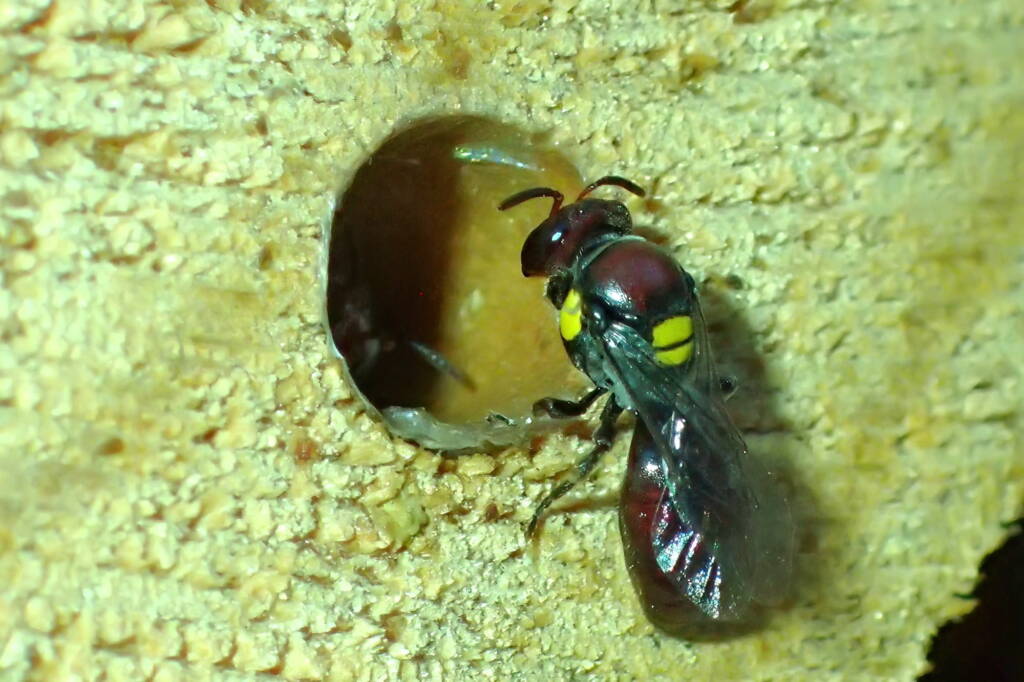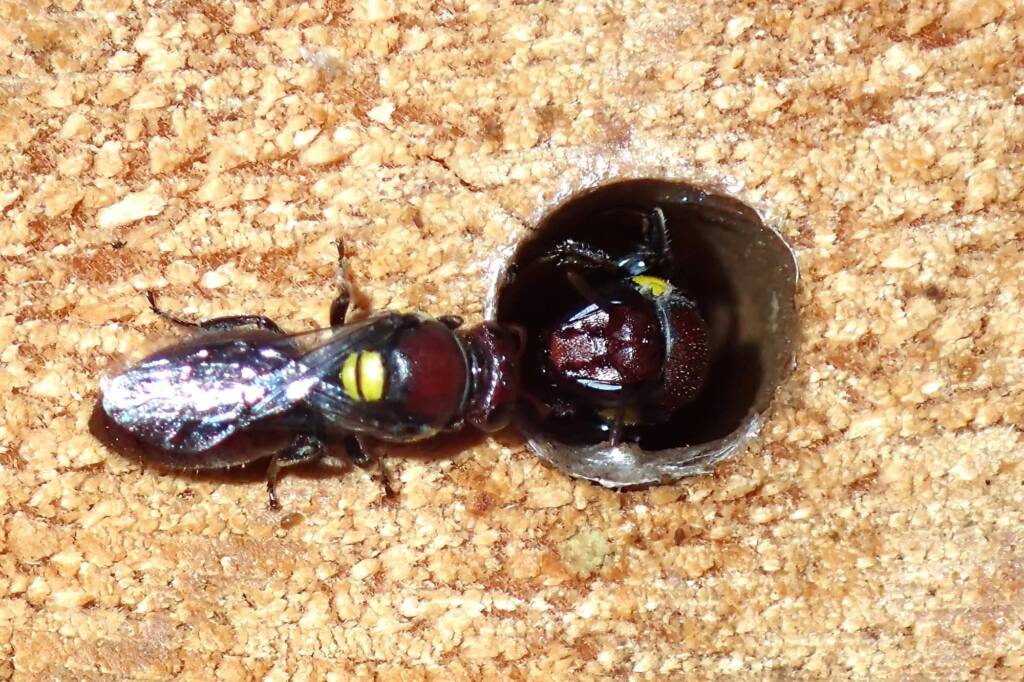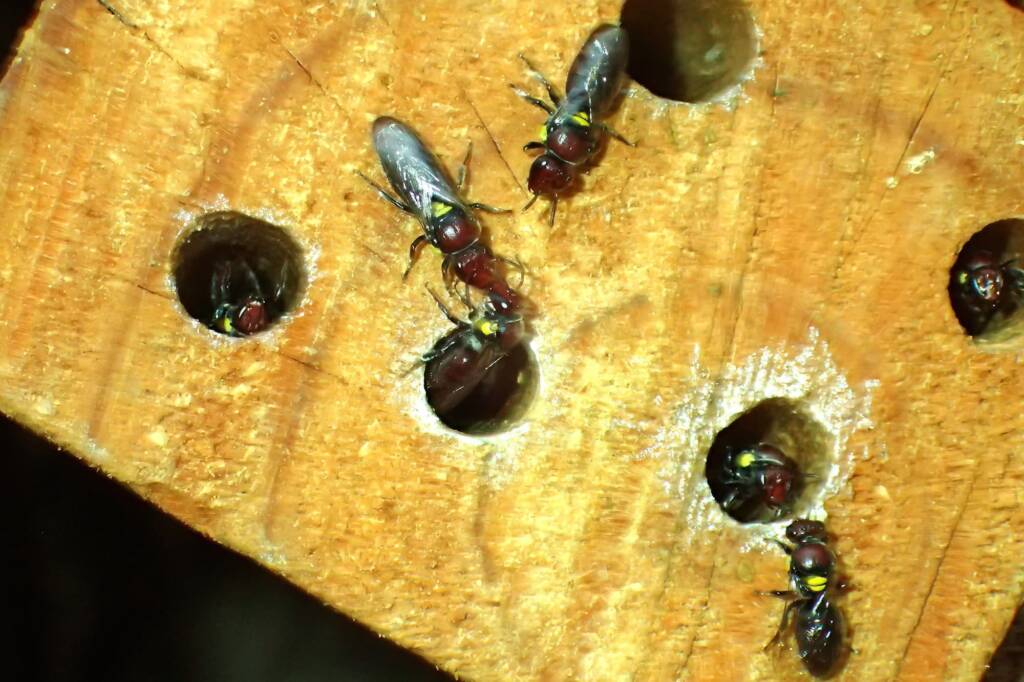Author Gary Taylor ◦
Righto, Meroglossa rubricata part 2, The young emerge* (*see footnote 😃)… But before I start, a couple of rhetorical questions, Do you have a dog or cat or other pet and can you tell what it’s thinking / saying / feeling by it’s body language? The swish of the tail, the angle of the ears… Well bees are just as readable but with them it’s all in the antennae. And these bees, probably due to their incredible longevity of life (compared to most bees) along with their communal house sharing lifestyle and (I believe) raising their young, are even more expressive than most… 🙂
So, 1st pic, Look at that stance, her arms all tucked up, it’s exactly what it looks like, polite patience. This is Mum trying to coax her young daughter out into the world, one antenna gently curving down towards her, the other on a slight angle pointing out, encouraging but understanding.

Then 2nd pic, the youngster pokes her head up and cries “But Mum I don’t wanna go to school…” 😄 Mum leans forward with one antenna still down and caring, the other still subtly showing the way out and says “I know sweetheart, but all the other kids will be there… you’ll make new friends, get to hang out at the shops, it’ll be fun, you’ll see…” 😅

Ok, a couple of things here… Firstly, we all know bees don’t talk with their mouths, that’d be silly 😄 In any other flying animal that rears it’s young, an image of the young one in a nest raising it’s head with mouth open to a parent like this, would instantly be recognised as the young one expecting or at least hoping for a feed… 😃 Another thing (and I’m fully prepared to accept that maybe in every pic I’ve ever taken of the young ones the angle or light was just wrong 😅), to me the mouth doesn’t look quite right… like the jaws aren’t fully developed or perhaps just tightly tucked away… Dunno, but then if you don’t start adult life having to chew your way through up to three (possibly more depending on sibling survival), solid doors just to get out of the house and have your first feed in months, then you don’t really need jaws do you… In fact if you were raised, mouth fed on a soft nutritious blend of regurgitated pollen and nectar, jaws may even be a hindrance…
3rd pic, Again that polite patient stance (just to prove the first wasn’t a one off 😅), tho’ this time it’s a youngster hoping Mum will let her back in… her antennae are gently curved and equally opposed off to the sides showing her pure polite and patient sweetness… 😇

4th pic, So I’ve made the outrageous statement that their young also seem to be noticeably smaller… (ridiculous, we all know bees pupate as fully grown adults… 😃), this is another “youngster” also asking Mum if she can come home. Tell me you can’t see the size difference… Oh it’s just the angle the supposed “young” one’s head is on that makes it look smaller you say… I say look at the yellow dot showing the side (and size) of Mum’s chest in the hole…🙂

And 5th pic, well there’s a whole story in this one but to keep it brief, the darker chick in the top of the pic lives in the hole kinda behind ‘er, and she’s sticky beakin’ roughly speakin’… 😄 Haha, I’m a poet… and I don’t even realise… 🤣 Anyway, she’s just watching her sister? niece? cousin? dunno, trying to coax her young one out, and again I see this mouth to mouth thing happening… what I think is that Mum, like any caring parent, basically starves the kids just a little when she thinks they’re ready to leave the nest, encouraging them to go fend for themselves… and what she’s passing to her child isn’t just one last energy boost of nectar but more importantly a sensory map to the source… 😃 So how did I jump to that conclusion? 😆 Haha yeah nah there was never a jump (apart from when I’d be totally engrossed in trying to capture some really cool beehaviour on camera and suddenly a dense little Moreton Bay fig would drop from way up in the massive tree and land with a loud “BANG!” on the sheet of tin just above my head and I’d damn near shit myself 🤣).

Nah, it’s been a 6 year long, slow meandering walk and I took the “scenic route” 😄 Just seen it many times before, Mum gives a reluctant young one the kiss of “life” and suddenly the young one takes off on a dead straight trajectory like she knows exactly where she’s going… and every time it’s coincidentally in the exact same direction her mum goes to feed… As for the girl in the bottom right of pic, that’s the same girl that was politely hoping to be allowed back in in the 3rd pic… you might need to click on the pic to see Mum’s face but you don’t need to be fluent in rubricata to guess that’s a “no” 😆 But again, surely I’m not the only one who can see a size difference here…
So what am I suggesting, that their exoskeletons aren’t quite set yet? like when you buy a bag of prawns and the shells are too soft to peel, still stuck to the meat below… room to grow a bit…? Again, dunno, haven’t figured that one out yet… But you gotta admit it’s interesting 😀 … and if they did have slightly soft exoskeletons it might explain why Mum goes to such an extent to coat the sharp edges around the entrance/exit to her nest with a thick soft lining before they emerge… 🙂 just sayin’.
* Footnote: the “proper” word for a solitary native bee emerging from its nest is “eclose”, but I’ve never liked that word, it just doesn’t flow, and I don’t reckon these bees were ever “closed” to be “eclosed” so suck it up grammar nazis, they’ve emerged… 😆
Photographs – Geraldton, Midwest WA © Gary Taylor
Check out the Gary’s other blogs about the Meroglossa rubricata:
an awesome “Commando roll” | Ruby… bubbling | Ruby and the wasp | Party at the nest | red is the weakest, the first to fade in low light | A white bubble | multicrystaline polyinverted refractionism… | suddenly something bigger came torpedoing out of the nest… | running out of room to add new apartments… | She lives on in her chosen nest protecting the family she’s raising | the young emerge | Changing the rules again…
See our Fauna section on Bees for more info on our gorgeous Meroglossa rubricata.
Footnote
Check out more blogs and contribution by Gary Taylor.
